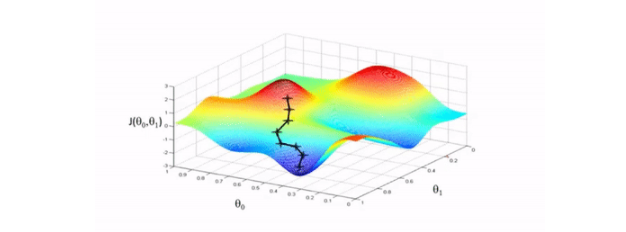本篇文章为大家展示了反向传播算法如何在python项目中实现,内容简明扼要并且容易理解,绝对能使你眼前一亮,通过这篇文章的详细介绍希望你能有所收获。
反向传播的目的是计算成本函数C对网络中任意w或b的偏导数。一旦我们有了这些偏导数,我们将通过一些常数 α的乘积和该数量相对于成本函数的偏导数来更新网络中的权重和偏差。这是流行的梯度下降算法。而偏导数给出了最大上升的方向。因此,关于反向传播算法,我们继续查看下文。
我们向相反的方向迈出了一小步——最大下降的方向,也就是将我们带到成本函数的局部最小值的方向。
图示演示:

反向传播算法中Sigmoid函数代码演示:
# 实现 sigmoid 函数
return 1 / (1 + np.exp(-x))
def sigmoid_derivative(x):
# sigmoid 导数的计算
return sigmoid(x)*(1-sigmoid(x))反向传播算法中ReLU 函数导数函数代码演示:
def relu_derivative(x): # ReLU 函数的导数
d = np.array(x, copy=True) # 用于保存梯度的张量
d[x < 0] = 0 # 元素为负的导数为 0
d[x >= 0] = 1 # 元素为正的导数为 1
return d实例扩展:
BP反向传播算法Python简单实现
import numpy as np
# "pd" 偏导
def sigmoid(x):
return 1 / (1 + np.exp(-x))
def sigmoidDerivationx(y):
return y * (1 - y)
if __name__ == "__main__":
#初始化
bias = [0.35, 0.60]
weight = [0.15, 0.2, 0.25, 0.3, 0.4, 0.45, 0.5, 0.55]
output_layer_weights = [0.4, 0.45, 0.5, 0.55]
i1 = 0.05
i2 = 0.10
target1 = 0.01
target2 = 0.99
alpha = 0.5 #学习速率
numIter = 10000 #迭代次数
for i in range(numIter):
#正向传播
neth2 = i1*weight[1-1] + i2*weight[2-1] + bias[0]
neth3 = i1*weight[3-1] + i2*weight[4-1] + bias[0]
outh2 = sigmoid(neth2)
outh3 = sigmoid(neth3)
neto1 = outh2*weight[5-1] + outh3*weight[6-1] + bias[1]
neto2 = outh3*weight[7-1] + outh3*weight[8-1] + bias[1]
outo1 = sigmoid(neto1)
outo2 = sigmoid(neto2)
print(str(i) + ", target1 : " + str(target1-outo1) + ", target2 : " + str(target2-outo2))
if i == numIter-1:
print("lastst result : " + str(outo1) + " " + str(outo2))
#反向传播
#计算w5-w8(输出层权重)的误差
pdEOuto1 = - (target1 - outo1)
pdOuto1Neto1 = sigmoidDerivationx(outo1)
pdNeto1W5 = outh2
pdEW5 = pdEOuto1 * pdOuto1Neto1 * pdNeto1W5
pdNeto1W6 = outh3
pdEW6 = pdEOuto1 * pdOuto1Neto1 * pdNeto1W6
pdEOuto2 = - (target2 - outo2)
pdOuto2Neto2 = sigmoidDerivationx(outo2)
pdNeto1W7 = outh2
pdEW7 = pdEOuto2 * pdOuto2Neto2 * pdNeto1W7
pdNeto1W8 = outh3
pdEW8 = pdEOuto2 * pdOuto2Neto2 * pdNeto1W8
# 计算w1-w4(输出层权重)的误差
pdEOuto1 = - (target1 - outo1) #之前算过
pdEOuto2 = - (target2 - outo2) #之前算过
pdOuto1Neto1 = sigmoidDerivationx(outo1) #之前算过
pdOuto2Neto2 = sigmoidDerivationx(outo2) #之前算过
pdNeto1Outh2 = weight[5-1]
pdNeto2Outh3 = weight[7-1]
pdEOuth2 = pdEOuto1 * pdOuto1Neto1 * pdNeto1Outh2 + pdEOuto2 * pdOuto2Neto2 * pdNeto1Outh2
pdOuth2Neth2 = sigmoidDerivationx(outh2)
pdNeth2W1 = i1
pdNeth2W2 = i2
pdEW1 = pdEOuth2 * pdOuth2Neth2 * pdNeth2W1
pdEW2 = pdEOuth2 * pdOuth2Neth2 * pdNeth2W2
pdNeto1Outh3 = weight[6-1]
pdNeto2Outh3 = weight[8-1]
pdOuth3Neth3 = sigmoidDerivationx(outh3)
pdNeth3W3 = i1
pdNeth3W4 = i2
pdEOuth3 = pdEOuto1 * pdOuto1Neto1 * pdNeto1Outh3 + pdEOuto2 * pdOuto2Neto2 * pdNeto2Outh3
pdEW3 = pdEOuth3 * pdOuth3Neth3 * pdNeth3W3
pdEW4 = pdEOuth3 * pdOuth3Neth3 * pdNeth3W4
#权重更新
weight[1-1] = weight[1-1] - alpha * pdEW1
weight[2-1] = weight[2-1] - alpha * pdEW2
weight[3-1] = weight[3-1] - alpha * pdEW3
weight[4-1] = weight[4-1] - alpha * pdEW4
weight[5-1] = weight[5-1] - alpha * pdEW5
weight[6-1] = weight[6-1] - alpha * pdEW6
weight[7-1] = weight[7-1] - alpha * pdEW7
weight[8-1] = weight[8-1] - alpha * pdEW8
# print(weight[1-1])
# print(weight[2-1])
# print(weight[3-1])
# print(weight[4-1])
# print(weight[5-1])
# print(weight[6-1])
# print(weight[7-1])
# print(weight[8-1])上述内容就是反向传播算法如何在python项目中实现,你们学到知识或技能了吗?如果还想学到更多技能或者丰富自己的知识储备,欢迎关注亿速云行业资讯频道。
亿速云「云服务器」,即开即用、新一代英特尔至强铂金CPU、三副本存储NVMe SSD云盘,价格低至29元/月。点击查看>>
免责声明:本站发布的内容(图片、视频和文字)以原创、转载和分享为主,文章观点不代表本网站立场,如果涉及侵权请联系站长邮箱:is@yisu.com进行举报,并提供相关证据,一经查实,将立刻删除涉嫌侵权内容。